Effect of Stirrups on Plate End Debonding in Reinforced Concrete Beams Strengthened with Fiber Reinforced Polymers
Abstract
:1. Introduction
1.1. PE Debonding Failure
1.2. Research Significance
2. Experimental Investigation
2.1. Test Beams
2.2. Materials
2.3. Strengthening Procedure
2.4. Test Setup and Instrumentation
3. Test Results and Discussion
3.1. Cracking Patterns and Modes of Failure
3.2. Ultimate Capacity
3.3. Load-Deflection Response
3.4. Strains in Reinforcement and Concrete
4. Comparison of Predicted and Experimental PE Debonding Capacity
5. Conclusions
- The PE debonding capacity of the beams increased with the increase in the amount of stirrups. Increasing the stirrup bar diameter or decreasing the stirrup spacing was found to increase the failure load of the beams.
- The effect of stirrups on PE debonding capacity was more pronounced for the beams with CFRP sheets terminated close to the supports when compared with those beams with CFRP sheets terminated away from the supports. This was because the shear cracks in the plate end region were less inclined in the beams with CFRP sheets terminated away from the supports. This reduced the efficiency of stirrups in restricting the opening of the shear cracks in this region, thus reducing the enhancement in PE debonding capacity due to the increase in stirrup amount.
- The stirrup amount appeared to affect the PE debonding mode of failure. Beams with the lowest amount of stirrups failed in PEI debonding or CDC debonding. Beams with larger amount of stirrups failed in CCS.
- Most of the existing prediction models did not capture the effect of stirrups on PE debonding capacity of the FRP-strengthened RC beams. Among the 15 prediction models used in this analysis, the models of El-Sayed et al. and Teng and Yao were found to well capture such an effect, with the best predictions provided by El-Sayed et al. model.
Author Contributions
Funding
Institutional Review Board Statement
Informed Consent Statement
Data Availability Statement
Conflicts of Interest
References
- Naser, M.Z.; Hawileh, R.A.; Abdalla, J.A. Fiber-reinforced polymer composites in strengthening reinforced concrete structures: A critical review. Eng. Struct. 2019, 198, 109542. [Google Scholar] [CrossRef]
- Shuraim, A.B.; El-Sayed, A.K.; Al-Negheimish, A.I.; Alhozaimy, A.M. Efficiency of CFRP strengthening in controlling the deflection of RC beams in a redundant structural system. J. Compos. Constr. 2016, 20, 04015054. [Google Scholar] [CrossRef]
- El-Sayed, A.K. Effect of longitudinal CFRP strengthening on the shear resistance of reinforced concrete beams. Compos. Part B 2014, 58, 422–429. [Google Scholar] [CrossRef]
- Funari, M.F.; Spadea, S.; Fabbrocino, F.; Luciano, R. A moving interface finite element formulation to predict dynamic edge debonding in FRP-strengthened concrete beams in service conditions. Fibers 2020, 8, 42. [Google Scholar] [CrossRef]
- Cascardi, A.; Leone, M.; Aiello, M.A. Transversal joining of multi-leaf masonry through different types of connector: Experimental and theoretical investigation. Constr. Build. Mater. 2020, 265, 120733. [Google Scholar]
- Al-Saawani, M.A.; El-Sayed, A.K.; Al-Negheimish, A.I. Effect of shear-span/depth ration on debonding failures of FRP-strengthened RC beams. J. Build. Eng. 2020, 32, 101771. [Google Scholar] [CrossRef]
- Teng, J.G.; Smith, S.T.; Yao, J.; Chen, J.F. Intermediate crack-induced debonding in RC beams and slabs. Constr. Build. Mater. 2003, 17, 447–462. [Google Scholar] [CrossRef]
- Rosenboom, O.; Rizkalla, S. Experimental study of intermediate crack debonding in fiber-reinforced polymer strengthened beams. ACI Struct. J. 2008, 105, 41–50. [Google Scholar]
- Al-Zaid, R.Z.; Al-Negheimish, A.I.; Al-Saawani, M.A.; El-Sayed, A.K. Analytical study on RC beams strengthened for flexure with externally bonded FRP reinforcement. Compos. Part B 2012, 43, 129–141. [Google Scholar] [CrossRef]
- Al-Negheimish, A.I.; El-Sayed, A.K.; Al-Zaid, R.A.; Shuraim, A.B.; Alhozaimy, A.M. Behavior of wide shallow RC beams strengthened with CFRP reinforcement. J. Compos. Constr. 2012, 16, 418–429. [Google Scholar] [CrossRef]
- Al-Zaid, R.A.; El-Sayed, A.K.; Al-Negheimish, A.I.; Shuraim, A.B.; Alhozaimy, A.M. Strengthening of structurally damaged wide shallow RC beams using externally bonded CFRP plates. Latin Am. J. Solids Struct. 2014, 11, 946–965. [Google Scholar] [CrossRef] [Green Version]
- Al-Saawani, M.A.; El-Sayed, A.K.; Al-Negheimish, A.I. Effect of basic design parameters on IC debonding of CFRP-strengthened shallow RC beams. J. Reinf. Plast. Compos. 2015, 34, 1526–1539. [Google Scholar] [CrossRef]
- Al-Saawani, M.A.; El-Sayed, A.K.; Al-Negheimish, A.I. Crack width prediction for concrete beams strengthened with carbon FRP composites. J. Compos. Constr. 2017, 21, 04017023. [Google Scholar] [CrossRef]
- El-Sayed, A.K.; Al-Saawani, M.A.; Al-Negheimish, A.I. Empirical shear based model for predicting plate end debonding in FRP strengthened RC beams. J. Civ. Eng. Manag. 2021, 27, 117–138. [Google Scholar] [CrossRef]
- Al-Ghrery, K.; Kalfat, R.; Al-Mahaidi, R.; Oukaili, N.; Al-Mosawe, A. Prediction of concrete cover separation in reinforced concrete beams strengthened with FR. J. Compos. Constr. 2021, 25, 04021022. [Google Scholar] [CrossRef]
- Al-Saawani, M.A.; El-Sayed, A.K.; Al-Negheimish, A.I. Assessment of plate-end debonding design provisions for RC beams strengthened with FRP. Latin Am. J. Solids Struct. 2020, 17, 1–28. [Google Scholar] [CrossRef]
- Ceci, A.M.; Casas, J.R.; Ghosn, M. Statistical analysis of existing models for flexural strengthening of concrete bridge beams using FRP sheets. Constr. Build. Mater. 2012, 27, 490–520. [Google Scholar] [CrossRef] [Green Version]
- Smith, S.T.; Teng, J.G. FRP-strengthened RC beams. I: Review of debonding strength models. Eng. Struct. 2002, 24, 385–395. [Google Scholar] [CrossRef]
- Smith, S.T.; Teng, J.G. FRP-strengthened RC beams. II: Assessment of debonding strength models. Eng. Struct. 2002, 24, 397–417. [Google Scholar] [CrossRef]
- Yao, J.; Teng, J.G. Plate end debonding in FRP-plated RC beams—I: Experiments. Eng. Struct. 2007, 29, 2457–2471. [Google Scholar] [CrossRef]
- Teng, J.G.; Yao, J. Plate end debonding in FRP-plated RC beams—II: Strength model. Eng. Struct. 2007, 29, 2472–2486. [Google Scholar] [CrossRef]
- Fu, B.; Teng, J.G.; Chen, J.F.; Chen, G.M.; Guo, Y.C. Concrete cover separation in FRP-plated RC beams: Mitigation using FRP U-jackets. J. Compos. Constr. 2017, 21, 1–13. [Google Scholar] [CrossRef]
- Hasnat, A.; Islam, M.; Amin, A. Enhancing the debonding strain limit for CFRP-strengthened RC beams using U-clamps: Identification of design parameters. J. Compos. Constr. 2016, 20, 1–16. [Google Scholar] [CrossRef]
- Ceroni, F.; Pecce, M.; Matthys, S.; Taerwe, L. Debonding strength and anchorage devices for reinforced concrete elements strengthened with FRP sheets. Compos. Part B 2008, 39, 429–441. [Google Scholar] [CrossRef]
- Chalioris, C.E.; Zapris, A.G.; Karayannis, C.G. U-jacketing applications of fiber-reinforced polymers in reinforced concrete T-beams against shear—Tests and design. Fibers 2020, 8, 13. [Google Scholar] [CrossRef] [Green Version]
- Chalioris, C.E.; Kosmidou, P.M.; Papadopoulos, N.A. Investigation of a new strengthening technique for RC deep beams using carbon FRP ropes as transverse reinforcements. Fibers 2018, 6, 52. [Google Scholar] [CrossRef] [Green Version]
- Bousselham, A.; Chaallal, O. Effect of transverse steel and shear span on the performance of RC beams strengthened in shear with CFRP. Compos. Part B Eng. 2006, 37, 37–46. [Google Scholar] [CrossRef]
- Garden, H.N.; Hollaway, L.C. An experimental study of the influence of plate end anchorage of carbon fibre composite plates used to strengthen reinforced concrete beams. Compos. Struct. 1998, 42, 175–188. [Google Scholar] [CrossRef]
- Garden, H.N.; Quantrill, R.J.; Hollaway, L.C.; Thorne, A.M.; Parke, G.A.R. An experimental study of the anchorage length of carbon fiber composite plates used to strengthen reinforced concrete beams. Constr. Build. Mater. 1998, 12, 203–219. [Google Scholar] [CrossRef]
- Smith, S.T.; Teng, J.G. Shear-bending interaction in debonding failures of FRP-plated RC beams. Adv. Struct. Eng. 2003, 6, 183–199. [Google Scholar] [CrossRef]
- Pham, H.; Al-Mahaidi, R. Experimental investigation into flexural retrofitting of reinforced concrete bridge beams using FRP composites. Compos. Struct. 2004, 66, 617–625. [Google Scholar] [CrossRef]
- Buyukozturk, O.; Gunes, O.; Karaca, E. Characterization and modeling of debonding in RC beams strengthened with FRP composies. In Proceedings of the 15th ASCE Engineering Mechanics Conference, Columbia Univsity, New York, NY, USA, 2–5 June 2002. [Google Scholar]
- Li, G.; Zhang, A.; Jin, W. Effect of shear resistance on flexural debonding load-carrying capacity of RC beams strengthened with externally bonded FRP composites. Polymers 2014, 6, 1366–1380. [Google Scholar] [CrossRef]
- Oehlers, D.J. Reinforced concrete beams with plates glued to their soffits. J. Struct. Eng. 1992, 118, 2023–2038. [Google Scholar] [CrossRef]
- Jansze, W. Strengthening of RC Members in Bending by Externally Bonded Steel Plates. Ph.D. Thesis, Delft University of Technology, Delft, The Netherlands, 1997. [Google Scholar]
- Ahmed, O.; Van Gemert, D. Effect of longitudinal carbon fiber reinforced plastic laminates on shear capacity of reinforced concrete beams. In Proceedings of the Fourth International Symposium on Fiber Reinforced Polymer Reinforcement for Reinforced Concrete Structures, Baltimore, MD, USA, 31 October–5 November 1999. [Google Scholar]
- Colotti, V.; Spadea, G.; Swamy, R.N. Structural model to predict the failure behavior of plated reinforced concrete beams. J. Compos. Constr. 2004, 8, 104–122. [Google Scholar] [CrossRef]
- International Federation for Structural Concrete. Externally Applied FRP Reinforcement for Concrete Structures; International Federation for Structural Concrete: Lausanne, Switzerland, 2019. [Google Scholar]
- ACI (American Concrete Institute). Guide for the Design and Construction of Externally Bonded FRP Systems for Strengthening Concrete Structures; ACI440.2R-17; ACI: Farmington Hills, MI, USA, 2017. [Google Scholar]
- Standards Australia. Bridge Design, Part 8: Rehabilitation and Strengthening of Existing Bridges; AS 5100.8; SA1 Global Limited: Sydney, Australia, 2017. [Google Scholar]
- Concrete Society Technical Report No. 55. Design Guidance for Strengthening Concrete Structures Using Fibre Composite Materials; Concrete Society: Crowthorne, UK, 2012. [Google Scholar]
- ACI (American Concrete Institute). Building Code Requirements for Structural Concrete; ACI318-19; ACI: Farmington Hills, MI, USA, 2019. [Google Scholar]
- American Society for Testing and Materials. Standard Test Method for Compressive Strength of Cylindrical Concrete Specimens; ASTM C39/C39M-18; ASTM: West Conshohocken, PA, USA, 2018. [Google Scholar]
- American Society for Testing and Materials. Standard Test Methods and Definitions for Mechanical Testing of Steel Products; ASTM A370-19e1; ASTM: West Conshohocken, PA, USA, 2019. [Google Scholar]
- Standards Australia. Bridge Design, Part 5: Concrete; AS 5100.5; SA1 Global Limited: Sydney, Australia, 2017. [Google Scholar]
- European Committee for Standardization. Eurocode 2: Design of Concrete Structures—Part 1-1: General Rules and Rules for Buildings; EN 1992-1-1; CEN: Brussels, Belgium, 2004. [Google Scholar]
- ACI (American Concrete Institute). Building Code Requirements for Structural Concrete and Commentary; ACI 318-14; ACI: Farmington Hills, MI, USA, 2014. [Google Scholar]
- Oehlers, D.J.; Liu, I.S.T.; Seracino, R.; Mohamed Ali, M.S. Prestress model for shear deformation debonding of FRP- and steel-plated RC beams. Mag. Conc. Res. 2004, 56, 475–486. [Google Scholar] [CrossRef]
- Oehlers, D.J.; Liu, I.S.T.; Seracino, R. Shear deformation debonding of adhesively bonded plates. Proc. Inst. Civ. Eng. Struct. Build. 2005, 158, 77–84. [Google Scholar] [CrossRef]
- Standards Australia. Concrete Structures (AS 3600); The Standards Association of Australia: Sydney, Australia, 1988. [Google Scholar]
- National Research Council. Guide for the Design and Construction of Externally Bonded FRP Systems for Strengthening Existing Structures; CNR-DT 200 R1; National Research Council: Rome, Italy, 2013. [Google Scholar]


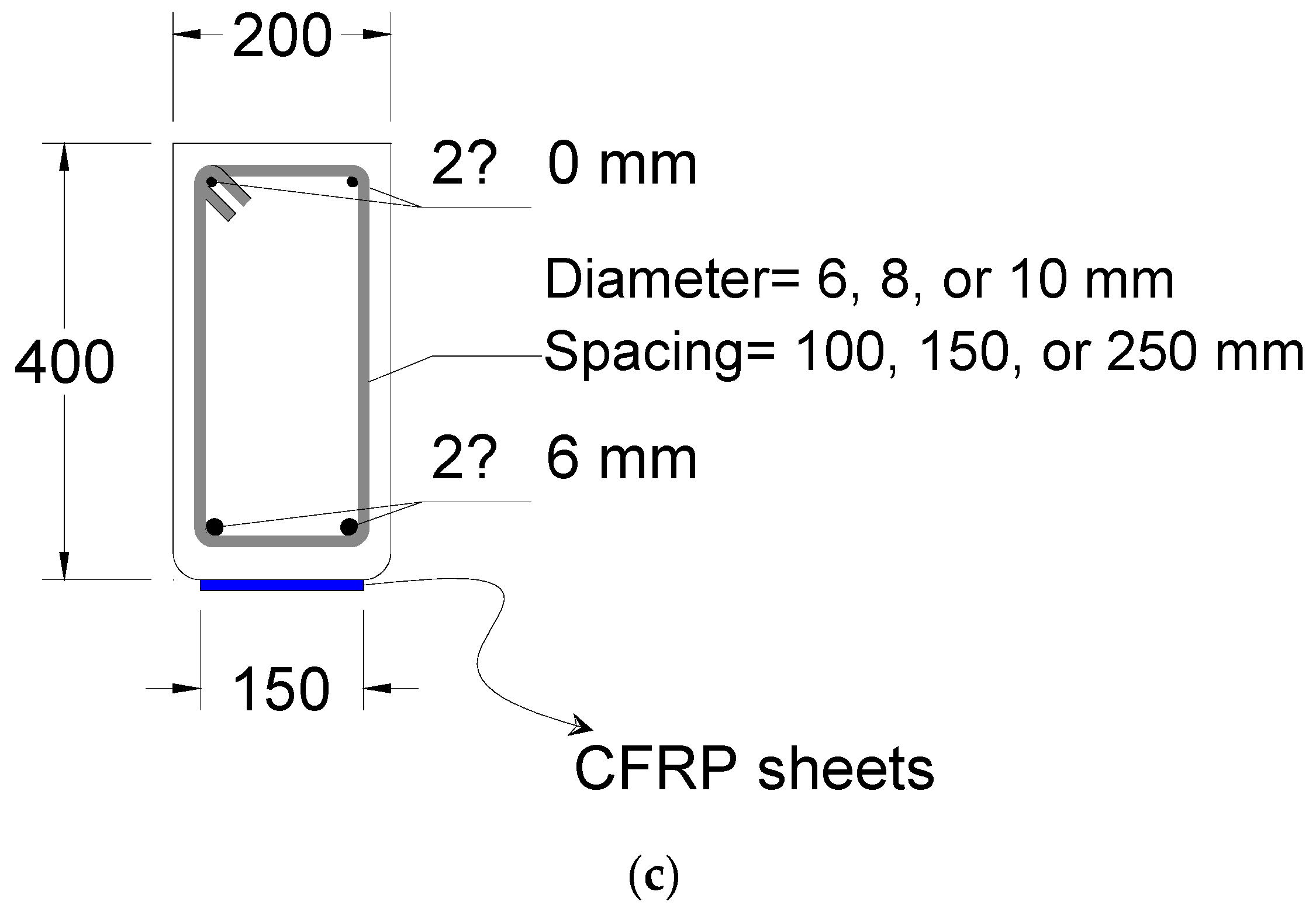


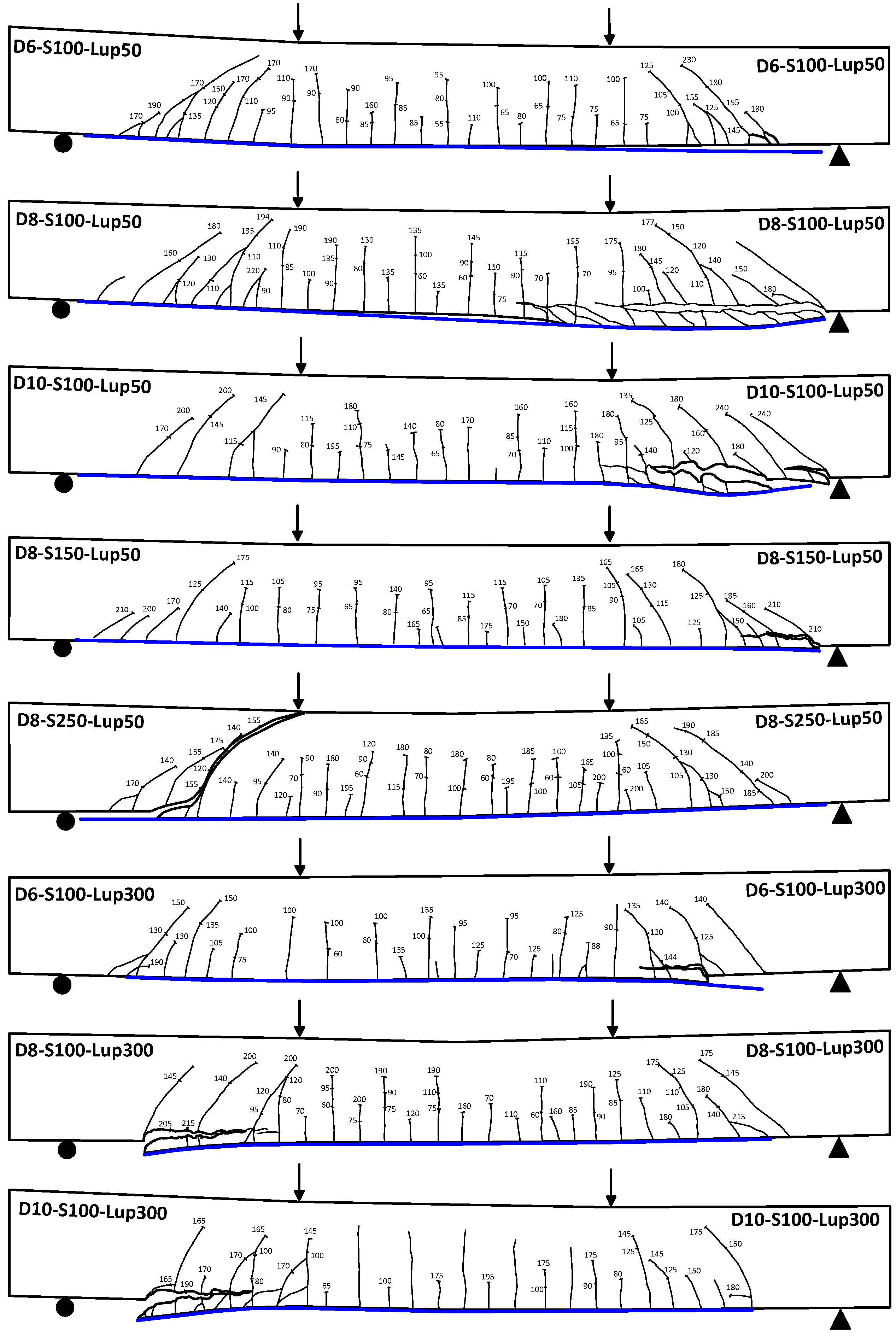
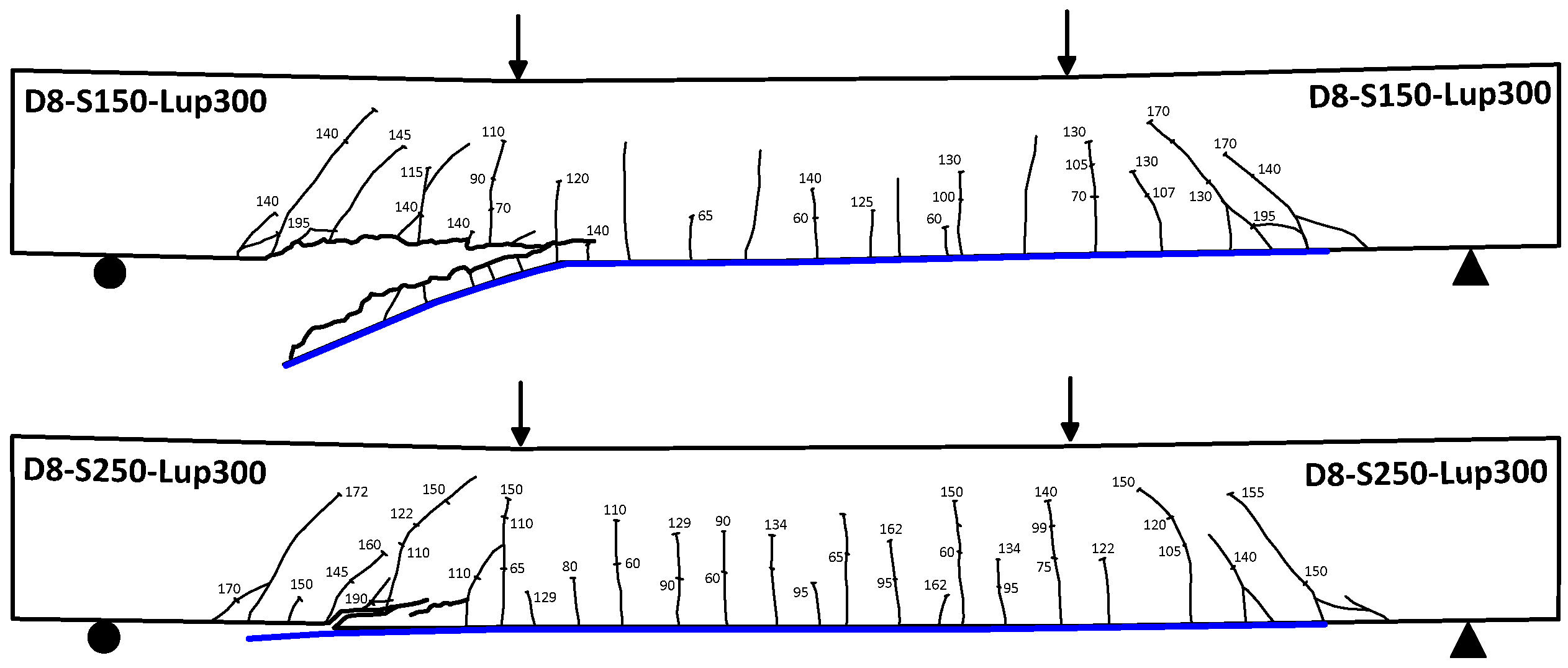
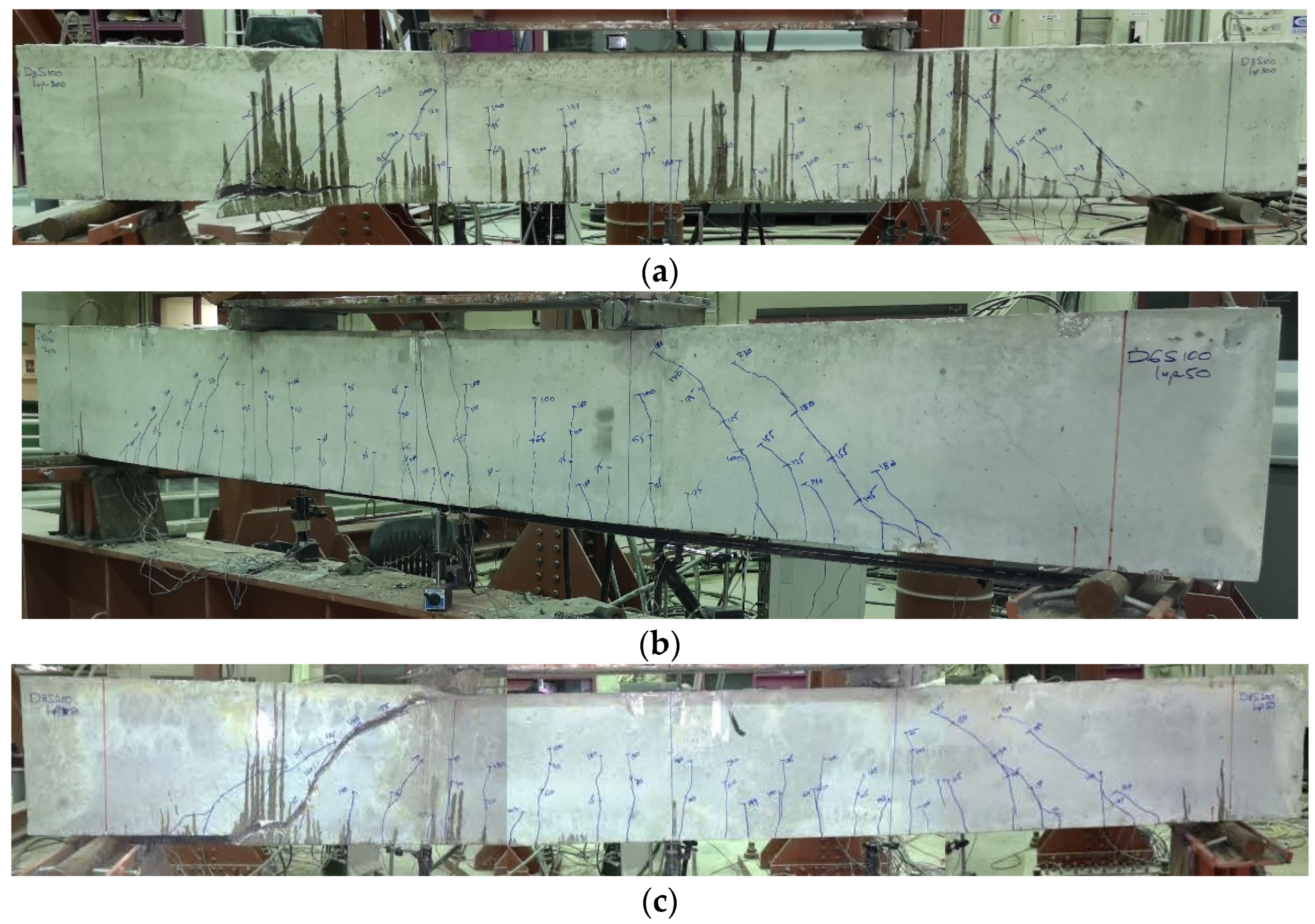

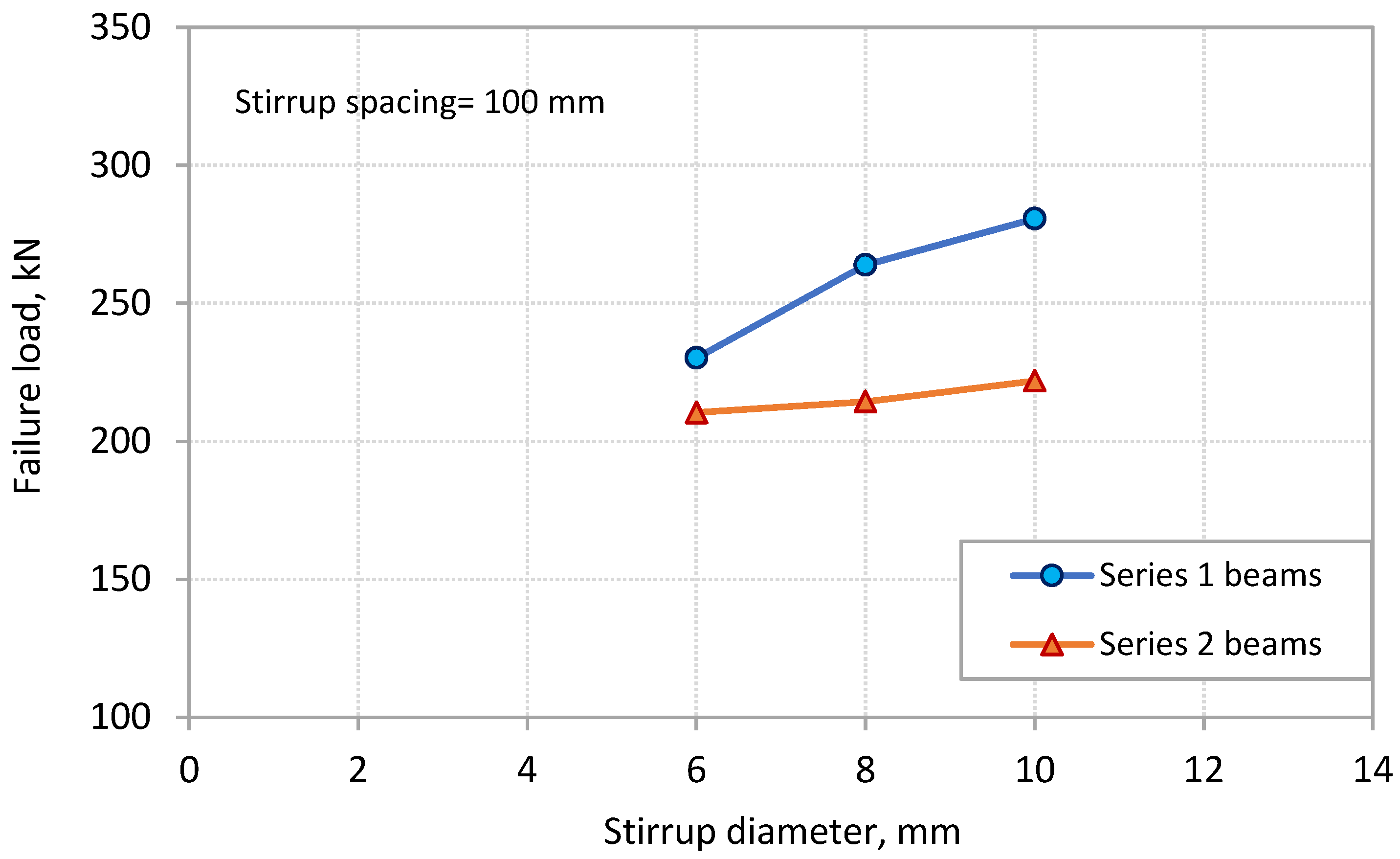

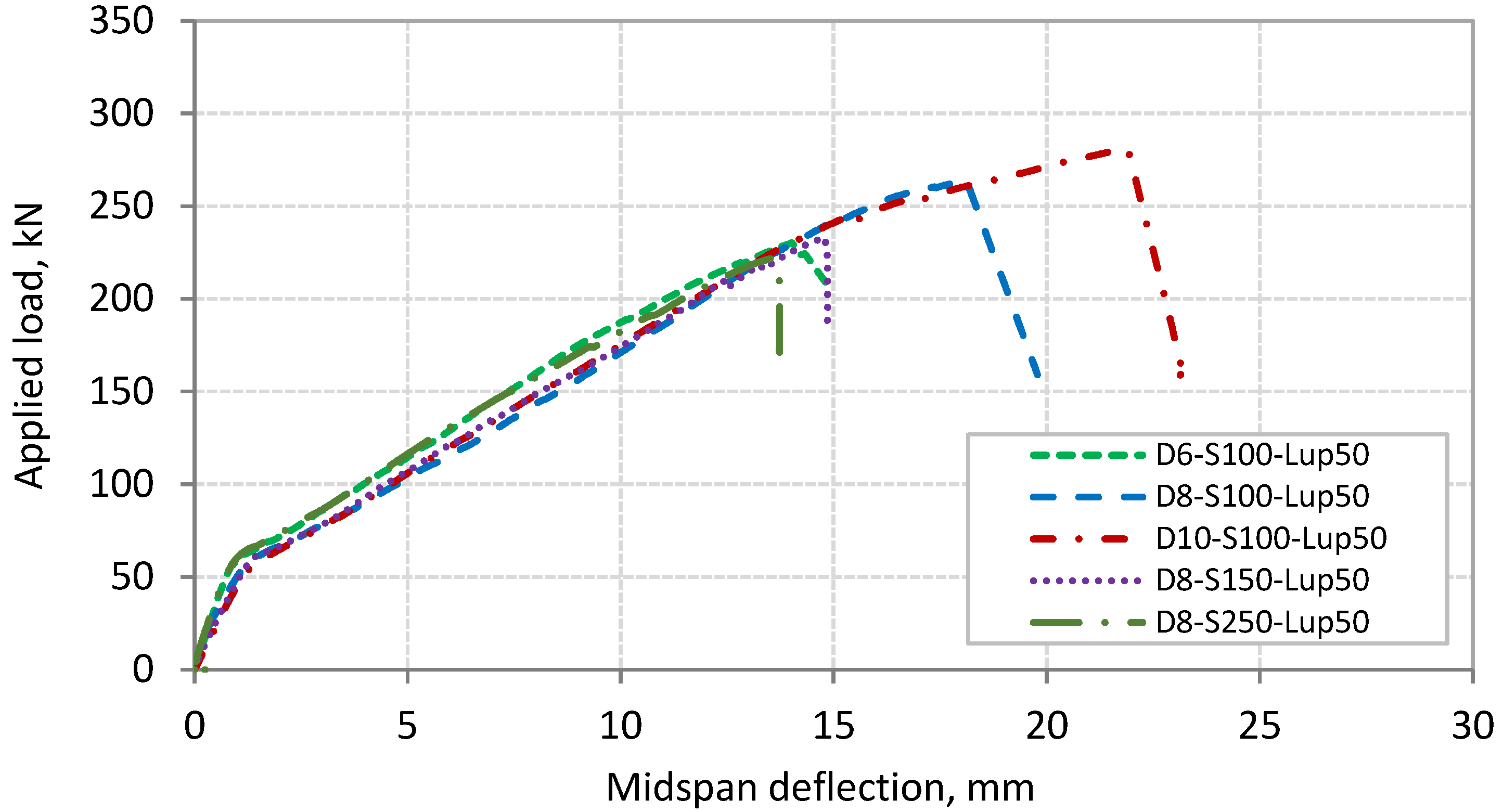

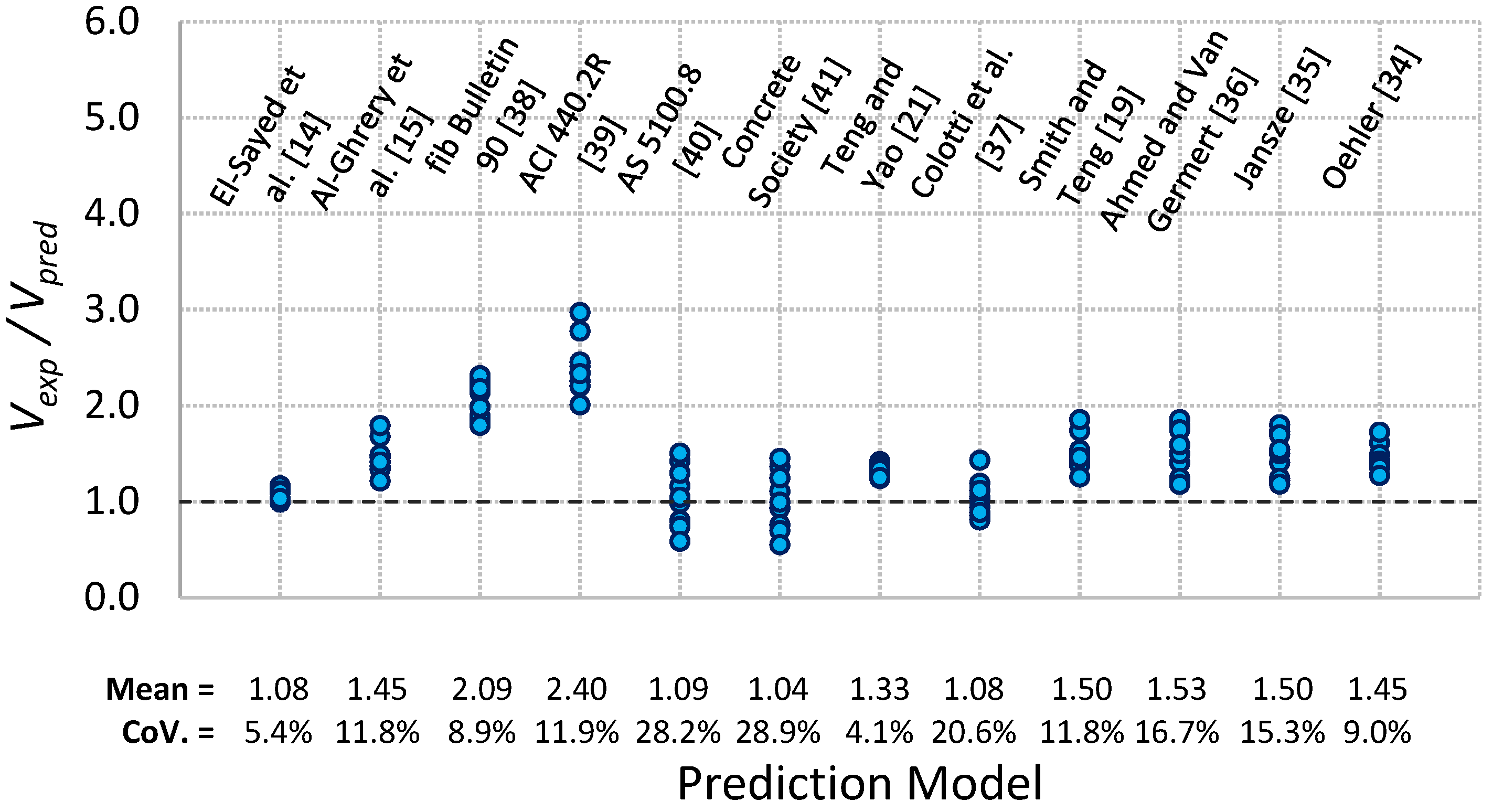
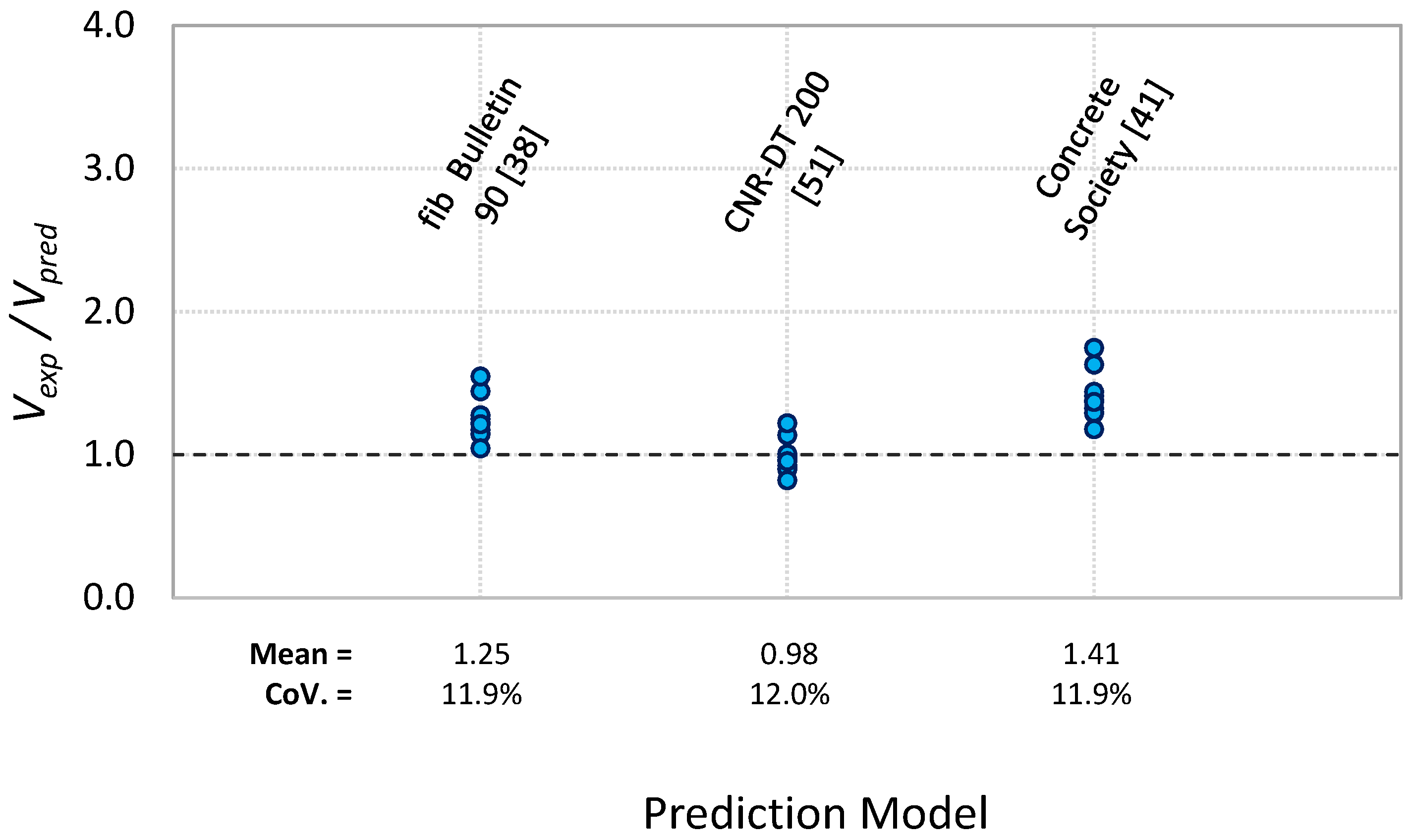
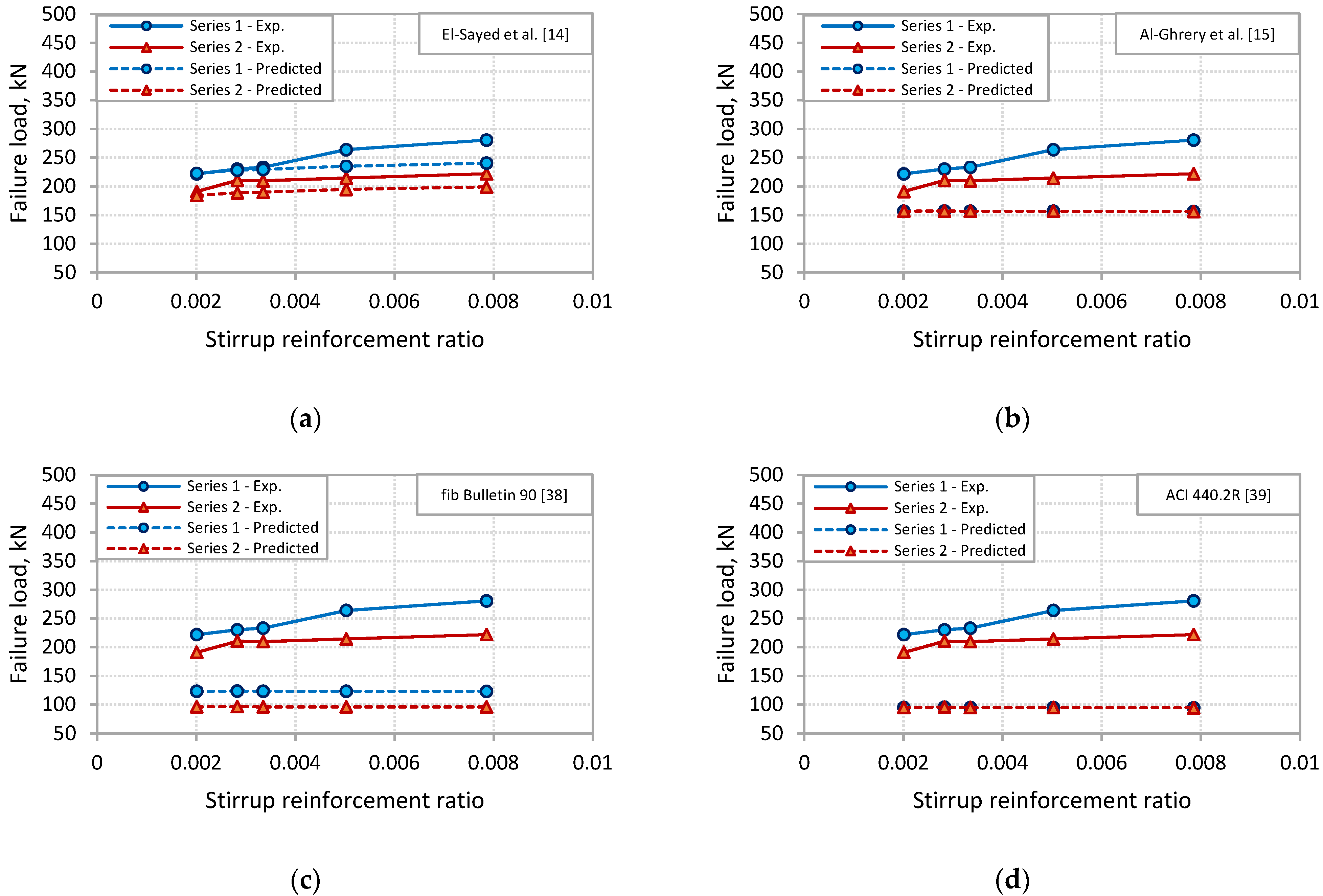
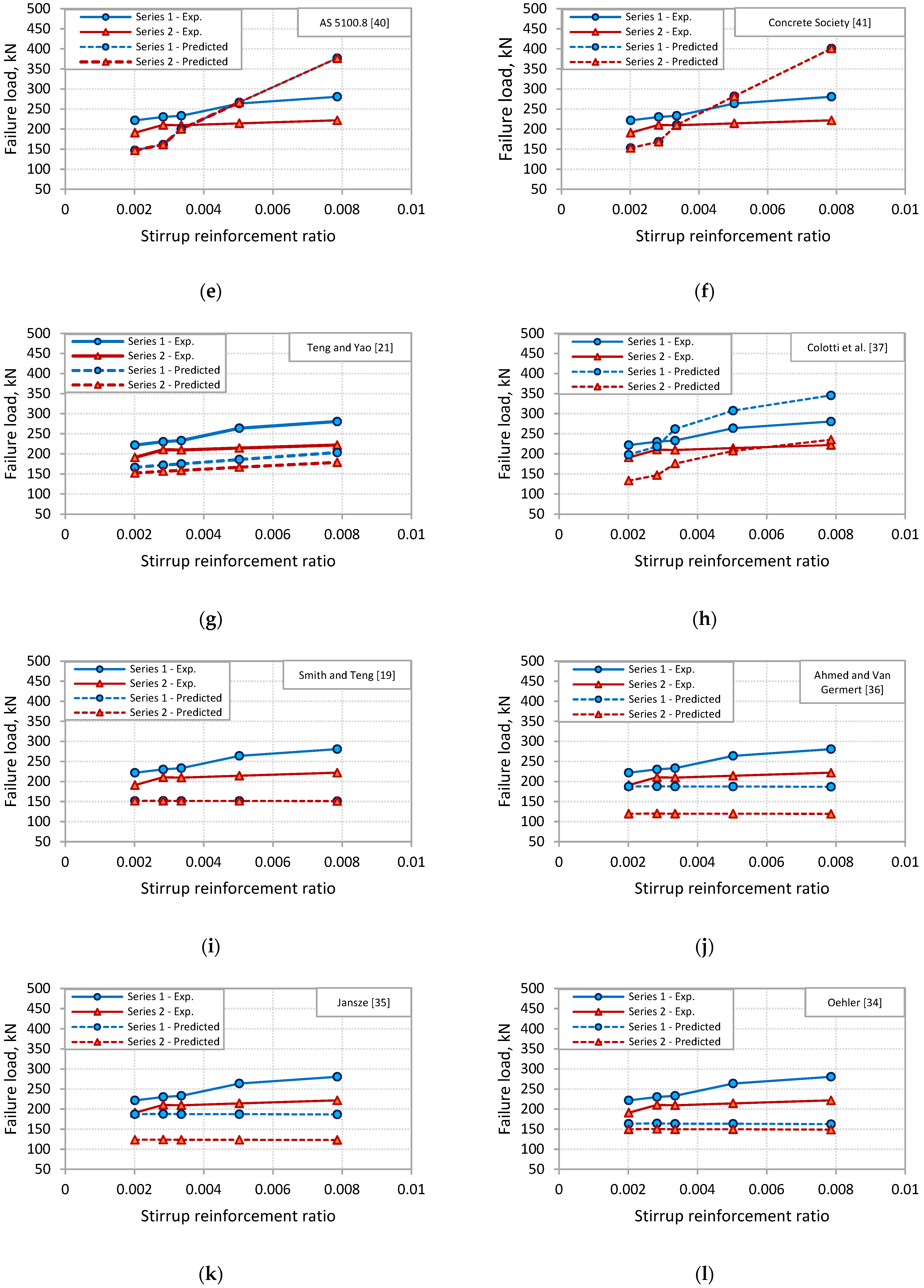
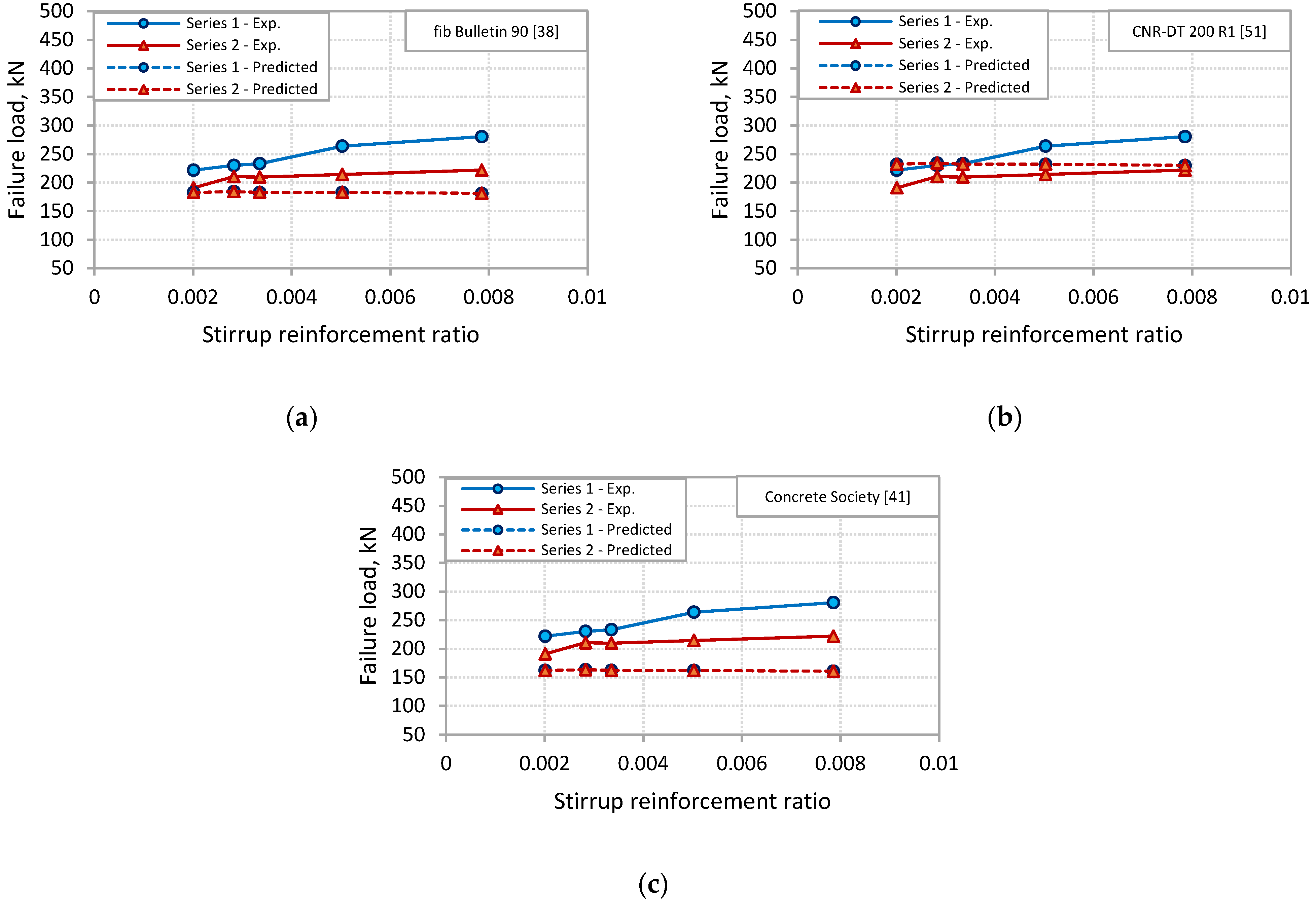
| Beam | Stirrup Diameter (mm) | Stirrup Spacing (mm) | Stirrup Reinforcement Ratio, ρsv (%) | Cutoff Distance, Lup (mm) | |
|---|---|---|---|---|---|
| Series 1 | D6-S100-Lup50 | 6 | 100 | 0.28 | 50 |
| D8-S100-Lup50 | 8 | 100 | 0.50 | ||
| D10-S100-Lup50 | 10 | 100 | 0.79 | ||
| D8-S150-Lup50 | 8 | 150 | 0.34 | ||
| D8-S250-Lup50 | 8 | 250 | 0.20 | ||
| Series 2 | D6-S100-Lup300 | 6 | 100 | 0.28 | 300 |
| D8-S100-Lup300 | 8 | 100 | 0.50 | ||
| D10-S100-Lup300 | 10 | 100 | 0.79 | ||
| D8-S150-Lup300 | 8 | 150 | 0.34 | ||
| D8-S250-Lup300 | 8 | 250 | 0.20 | ||
| Material | Yield Stress (MPa) (CoV) | Ultimate Tensile Stress (MPa) (CoV) | Elastic Modulus (GPa) | εfu |
|---|---|---|---|---|
| Steel (6 mm) | 310 (4.5%) | 380 (3.6%) | 200 | - |
| Steel (8 mm) | 400 (3.8%) | 586 (3.5%) | 200 | - |
| Steel (10 mm) | 500 (1.5%) | 574 (2.5%) | 200 | - |
| Steel (16 mm) | 560 (3.5%) | 707 (2.0%) | 205 | - |
| Carbon fabric | - | 3790 | 230 | 0.0165 |
| Adhesive | - | 72.4 | 3.18 | 0.05 |
| No. | Beam | Failure Load (kN) | Midspan Deflection at Failure (mm) | Strains at Failure (με) | Mode of Failure * | |||
|---|---|---|---|---|---|---|---|---|
| Concrete | Tension Steel Bars | CFRP | Steel Stirrups | |||||
| 1 | D6-S100-Lup50 | 230.2 | 14 | 1150 | 2900 | 3260 | 2260 | PEI |
| 2 | D8-S100-Lup50 | 263.9 | 18.1 | 1440 | 3800 | 4250 | 1400 | CCS |
| 3 | D10-S100-Lup50 | 280.6 | 21.8 | 1620 | 4640 | 5080 | 1270 | CCS |
| 4 | D8-S150-Lup50 | 233.2 | 14.8 | 1500 | 3000 | 3770 | 3110 | CCS |
| 5 | D8-S250-Lup50 | 221.8 | 13.6 | 1050 | 2850 | 3170 | 3940 | CDC |
| 6 | D6-S100-Lup300 | 210.4 | 12.6 | 1020 | 2700 | 3120 | 1830 | PEI |
| 7 | D8-S100-Lup300 | 214.4 | 14.2 | 1030 | 2800 | 3200 | 1370 | CCS |
| 8 | D10-S100-Lup300 | 221.9 | 14.5 | 1100 | 2900 | 3300 | 1170 | CCS |
| 9 | D8-S150-Lup300 | 209.7 | 13.6 | 950 | 2700 | 3100 | 1440 | CCS |
| 10 | D8-S250-Lup300 | 190.9 | 11.4 | 860 | 2480 | 2800 | 2540 | PEI |
| Reference | Debonding Criteria (Units: N and mm) |
|---|---|
| El-Sayed et al. [14] | Additionally, the equivalent effective depth deq and equivalent reinforcement ratio ρeq are as given by The factors and account for the influence of the shear reinforcement and the location of FRP cutoff point, respectively, and are given by |
| Al-Ghrery et al. [15] | |
| fib Bulletin 90 [38] | |
| ACI 440.2R [39] | An upper limit for the factored shear force at the termination point of the plate was provided to avoid PE debonding:
|
| AS 5100.8 [40] | An upper limit for the acting shear force at the plate end region was suggested by
|
| Concrete Society [41] | An upper limit for the acting shear force at the plate end region is suggested to avoid PE debonding:
|
| Teng and Yao [21] | The flexural debonding moment of FRP plate end located in a pure bending region is
The debonding shear force at an FRP plate end located in a region of (nearly) zero moment is An interaction between plate end shear and bending was proposed as follows: |
| Colotti et al. [37] | The ultimate shear load for the plate end failure mode of FRP-strengthened beam is
The limiting bond strength, , is given by |
| Smith and Teng [19] | The debonding shear force at the plate end, , is given by
|
| Ahmed and Van Germert [36] | The critical shear force at the FRP plate end that causes debonding, , is given as a function of the shearing stress, , by
The equivalent steel plate is the one that has the same tensile capacity and width as that of the FRP plate but with an equivalent thickness determined, assuming that the yield stress of steel is 550 MPa. The terms and are the moments of inertia of a cracked plated section with FRP plates and equivalent steel plates, respectively. and are the widths of FRP plate and adhesive, respectively. The terms and are the cross sectional area and yield stress of the steel stirrups, respectively, whereas s is the stirrup spacing. |
| Jansze [35] | The critical shear force at the FRP plate end that causes debonding, , is given as a function of the shearing stress, , by
|
| Oehler [34] | The ultimate debonding moment is given by the following equation: |
| Reference | Debonding Criteria (Units: N and mm) |
|---|---|
| fib Bulletin 90 [38] | |
| CNR DT200 [51] | |
| Concrete Society TR55 [41] |
| No. | Vexp (kN) | Experimental to Predicted Shear Load at Failure, Vexp/Vpred | |||||||||||
|---|---|---|---|---|---|---|---|---|---|---|---|---|---|
| El-Sayed et al. [14] | Al-Ghrery et al. [15] | Fib Bulletin 90 [38] | ACI 440. 2R [39] | AS 5100.8 [40] | Concrete Society [41] | Teng and Yao [21] | Colotti et al. [37] | Smith and Teng [19] | Ahmed and Van Germert [36] | Jansze [35] | Oehler [34] | ||
| 1 | 115.1 | 1.01 | 1.46 | 1.86 | 2.41 | 1.43 | 1.37 | 1.34 | 1.05 | 1.51 | 1.22 | 1.22 | 1.40 |
| 2 | 132.0 | 1.12 | 1.68 | 2.14 | 2.78 | 0.99 | 0.94 | 1.42 | 0.86 | 1.74 | 1.41 | 1.41 | 1.61 |
| 3 | 140.3 | 1.17 | 1.79 | 2.28 | 2.97 | 0.74 | 0.70 | 1.38 | 0.81 | 1.86 | 1.50 | 1.50 | 1.73 |
| 4 | 116.6 | 1.02 | 1.49 | 1.89 | 2.46 | 1.16 | 1.11 | 1.33 | 0.89 | 1.54 | 1.24 | 1.24 | 1.43 |
| 5 | 110.9 | 1.00 | 1.41 | 1.80 | 2.34 | 1.51 | 1.45 | 1.33 | 1.12 | 1.46 | 1.18 | 1.18 | 1.36 |
| 6 | 105.2 | 1.11 | 1.34 | 2.18 | 2.20 | 1.30 | 1.25 | 1.34 | 1.43 | 1.38 | 1.75 | 1.70 | 1.40 |
| 7 | 107.2 | 1.10 | 1.37 | 2.23 | 2.26 | 0.80 | 0.76 | 1.29 | 1.03 | 1.41 | 1.79 | 1.74 | 1.43 |
| 8 | 111.0 | 1.11 | 1.42 | 2.31 | 2.35 | 0.59 | 0.55 | 1.24 | 0.94 | 1.47 | 1.86 | 1.80 | 1.49 |
| 9 | 104.9 | 1.10 | 1.34 | 2.18 | 2.21 | 1.05 | 1.00 | 1.32 | 1.19 | 1.38 | 1.75 | 1.70 | 1.40 |
| 10 | 95.5 | 1.04 | 1.22 | 1.99 | 2.01 | 1.30 | 1.25 | 1.25 | 1.43 | 1.26 | 1.59 | 1.55 | 1.27 |
| Mean= | 1.08 | 1.45 | 2.09 | 2.40 | 1.09 | 1.04 | 1.33 | 1.08 | 1.50 | 1.53 | 1.50 | 1.45 | |
| CoV.= | 5.4% | 11.8% | 8.9% | 11.9% | 28.2% | 28.9% | 4.1% | 20.6% | 11.8% | 16.7% | 15.3% | 9.0% | |
| No. | Vexp (kN) | Experimental to Predicted Shear Load at Failure, Vexp/Vpred | ||
|---|---|---|---|---|
| Fib Bulletin 90 [38] | CNR-DT 200 [51] | Concrete Society [41] | ||
| 1 | 115.1 | 1.25 | 0.98 | 1.41 |
| 2 | 132.0 | 1.44 | 1.14 | 1.63 |
| 3 | 140.3 | 1.55 | 1.22 | 1.75 |
| 4 | 116.6 | 1.28 | 1.00 | 1.44 |
| 5 | 110.9 | 1.21 | 0.96 | 1.37 |
| 6 | 105.2 | 1.14 | 0.90 | 1.29 |
| 7 | 107.2 | 1.17 | 0.92 | 1.32 |
| 8 | 111.0 | 1.22 | 0.96 | 1.38 |
| 9 | 104.9 | 1.15 | 0.90 | 1.29 |
| 10 | 95.5 | 1.04 | 0.82 | 1.18 |
| Mean= | 1.25 | 0.98 | 1.41 | |
| CoV.= | 11.9% | 12.0% | 11.9% | |
Publisher’s Note: MDPI stays neutral with regard to jurisdictional claims in published maps and institutional affiliations. |
© 2021 by the authors. Licensee MDPI, Basel, Switzerland. This article is an open access article distributed under the terms and conditions of the Creative Commons Attribution (CC BY) license (https://creativecommons.org/licenses/by/4.0/).
Share and Cite
Al-Negheimish, A.I.; El-Sayed, A.K.; Al-Saawani, M.A.; Alhozaimy, A.M. Effect of Stirrups on Plate End Debonding in Reinforced Concrete Beams Strengthened with Fiber Reinforced Polymers. Polymers 2021, 13, 3322. https://doi.org/10.3390/polym13193322
Al-Negheimish AI, El-Sayed AK, Al-Saawani MA, Alhozaimy AM. Effect of Stirrups on Plate End Debonding in Reinforced Concrete Beams Strengthened with Fiber Reinforced Polymers. Polymers. 2021; 13(19):3322. https://doi.org/10.3390/polym13193322
Chicago/Turabian StyleAl-Negheimish, Abdulaziz I., Ahmed K. El-Sayed, Mohammed A. Al-Saawani, and Abdulrahman M. Alhozaimy. 2021. "Effect of Stirrups on Plate End Debonding in Reinforced Concrete Beams Strengthened with Fiber Reinforced Polymers" Polymers 13, no. 19: 3322. https://doi.org/10.3390/polym13193322






